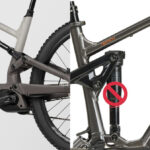Thinking about adding a stationary bike to your home gym? Excellent choice! Stationary bikes are a fantastic way to boost your cardio, get in a low-impact workout, and conveniently exercise from the comfort of your home. However, before you jump in and purchase the first bike you see, it’s crucial to understand that not all stationary bikes are created equal. Just like traditional bicycles, stationary bikes come in various types, each designed with specific features and benefits to suit different fitness goals and preferences.
This guide will explore the diverse world of stationary bikes, breaking down the five main categories: recumbent bikes, upright bikes, indoor cycling bikes, air bikes, and folding bikes. By understanding the nuances of each type, you can confidently choose the perfect stationary bike to meet your individual needs and propel you towards your fitness aspirations.
Understanding Stationary Bikes
Before we delve into the specific types, let’s briefly touch upon what stationary bikes are and why they are a popular fitness choice. Simply put, a stationary bike, also known as an exercise bike, is a fitness machine that mimics the action of cycling but without moving forward. They provide a fantastic cardiovascular workout, helping to elevate your heart rate, burn calories, and improve overall fitness.
The benefits of incorporating a stationary bike into your routine are numerous:
- Cardiovascular Health Improvement: Regular cycling strengthens your heart and lungs, reducing the risk of heart disease and improving blood pressure.
- Convenient and Time-Efficient Workouts: Perfect for squeezing in a workout regardless of the weather or time constraints. Many bikes offer pre-programmed workouts for guided sessions.
- Low-Impact Exercise: Gentle on the joints, making them suitable for individuals of all fitness levels, including those recovering from injuries or with joint pain.
- Muscle Strengthening: While primarily a cardio machine, stationary bikes engage leg muscles, core, and even arms in some models, contributing to overall muscle tone and strength.
- Mental Well-being Boost: Exercise, including cycling, has been proven to reduce stress, improve mood, and enhance mental clarity.
With these benefits in mind, let’s explore the different Types Of Stationary Bikes to find the perfect match for your fitness journey.
Exploring the Different Types of Stationary Bikes
The world of stationary bikes is more diverse than you might think. Each type offers a unique riding experience and caters to different workout styles and user needs.
Indoor Cycling Bikes
Indoor cycling bikes, often referred to as spin bikes, are perhaps the most recognizable type of stationary bike, largely thanks to the popularity of studio cycling classes and brands like Peloton. They are designed to closely mimic the feel of riding a road bike, making them a favorite for those seeking an intense and engaging workout.
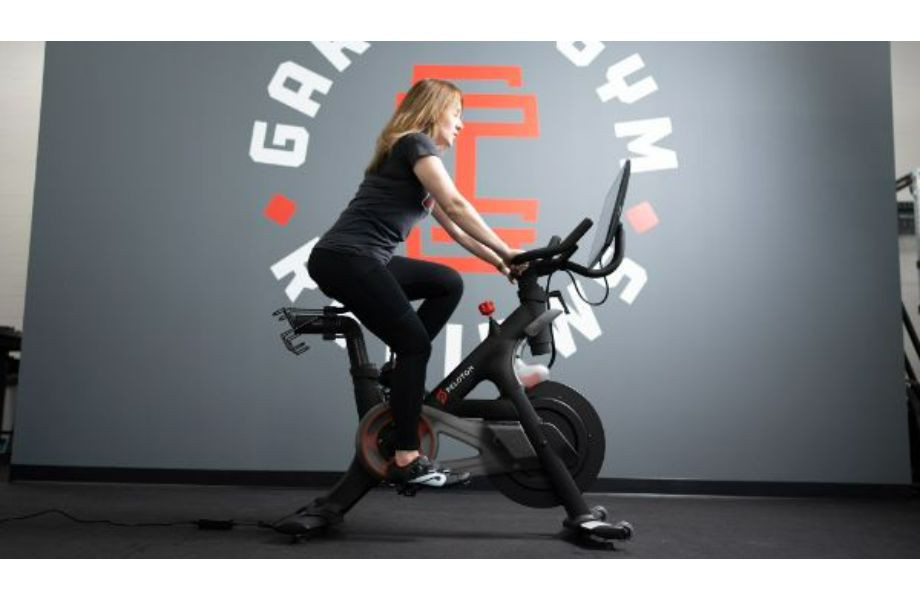 woman riding peloton bike
woman riding peloton bike
Key Features of Indoor Cycling Bikes:
- Road Bike Feel: The handlebar and seat positioning encourages a slight forward lean, similar to a traditional road bike, allowing for transitions between seated and standing positions during workouts.
- Flywheel Resistance: Typically feature an exposed flywheel at the front, using friction or magnetic resistance to create varying levels of workout intensity. Resistance is often adjusted manually via a knob, with some high-end models offering digital adjustments.
- Pedal and Shoe Options: Pedals can be caged to accommodate regular gym shoes or clip-in, requiring special cycling shoes for a more secure and efficient pedal stroke.
- Narrow Seat: Characterized by a smaller, firmer seat, although many models allow for seat replacements for enhanced comfort.
- Workout Intensity: Ideal for high-intensity interval training (HIIT), endurance rides, and simulated hill climbs.
Pros of Indoor Cycling Bikes:
- Wide Variety of Options: A vast market with bikes ranging from budget-friendly to high-end, offering features for every price point.
- Mimics Outdoor Cycling: Provides the closest simulation to riding a road bike indoors, appealing to cycling enthusiasts.
- User-Controlled Resistance: Allows for precise adjustments to workout intensity, putting you in control of your challenge.
- Excellent for High-Intensity Training: Designed for vigorous workouts that elevate your heart rate and burn significant calories.
- Compact Footprint: Generally smaller than other cardio machines, making them suitable for home gyms with limited space.
Cons of Indoor Cycling Bikes:
- Potential for Injury with Poor Form: Incorrect posture or technique, particularly during high-intensity workouts, can lead to discomfort or injury, especially back pain.
- Limited Upper Body Engagement: Primarily focuses on lower body workout with minimal upper body involvement.
- Seat Discomfort: The narrow, firm seat can be uncomfortable for some users, especially during longer rides.
- Noise Level: Friction-based resistance systems can sometimes generate noise, although magnetic resistance bikes are generally quieter.
Recumbent Bikes
Recumbent bikes offer a distinctly different cycling experience compared to indoor cycling bikes. Designed for comfort and accessibility, they position the rider in a reclined posture with a supportive backrest, making them an excellent option for individuals seeking a low-impact, comfortable workout, or those with specific physical needs.
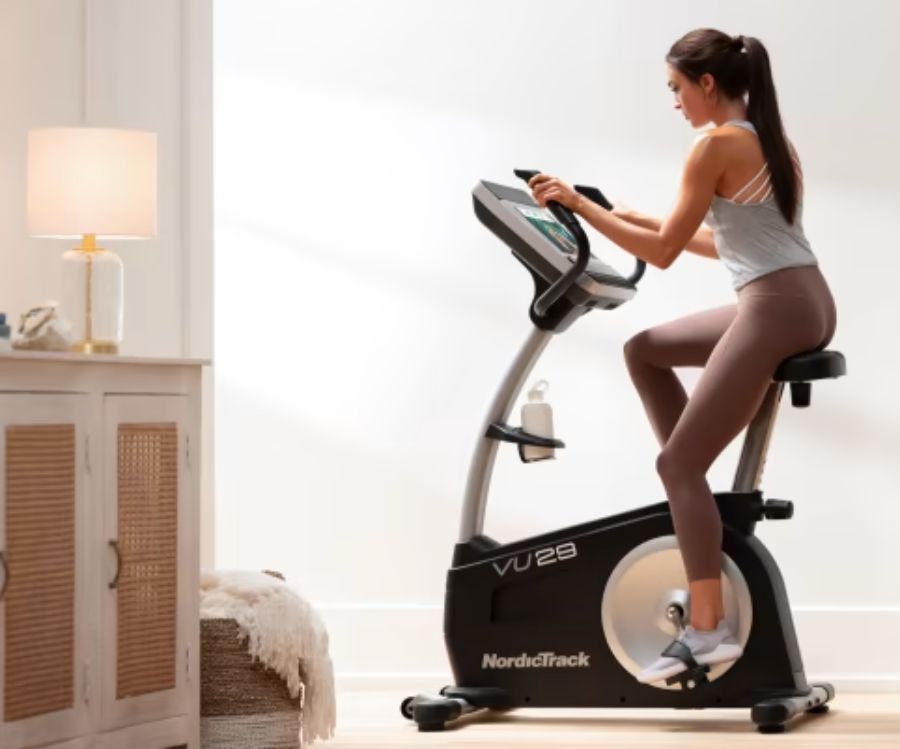 Woman riding an upright bike
Woman riding an upright bike
Key Features of Recumbent Bikes:
- Reclined Seating Position: Places the rider in a laid-back position with a backrest, providing excellent lumbar support and reducing strain on the back and joints.
- Pedals in Front: Pedals are positioned in front of the body rather than directly underneath, promoting a more relaxed leg extension and further reducing joint stress.
- Large, Comfortable Seat: Features a wider, often padded seat with a backrest, enhancing comfort, especially for longer workouts.
- Low Impact: Considered the lowest impact type of stationary bike due to the reclined position and reduced weight-bearing on joints.
- Accessibility: Easier to mount and dismount, making them suitable for seniors, individuals with mobility limitations, or those recovering from injuries.
Pros of Recumbent Bikes:
- Enhanced Comfort: The reclined position and back support prioritize comfort, making workouts more enjoyable, especially for those with back pain or discomfort.
- Excellent Back Support: The backrest provides crucial lumbar support, reducing strain and promoting proper posture during exercise.
- Extremely Low Impact: Minimizes stress on joints, making them ideal for individuals with arthritis, joint pain, or recovering from lower body injuries.
- Accessible Design: Easy to get on and off, accommodating users with varying levels of mobility.
- Lower to the Ground: Provides a sense of stability and security, particularly beneficial for elderly users or those with balance concerns.
Cons of Recumbent Bikes:
- Less Core Engagement: The reclined position reduces core muscle activation compared to upright bikes.
- Limited Workout Versatility: Typically only ridden in a seated position, limiting workout variations and the ability to stand for higher intensity bursts.
- Larger Footprint: Generally take up more space than upright or indoor cycling bikes due to their extended length.
- Lower Calorie Burn Potential: While still effective for cardio, the lower intensity nature of recumbent biking might result in a slightly lower calorie burn compared to more intense bike types for the same duration.
Upright Bikes
Upright bikes strike a balance between the intensity of indoor cycling bikes and the comfort of recumbent bikes. They offer a more traditional cycling posture than recumbent bikes but are generally less aggressive than indoor cycling bikes. Often mistaken for indoor cycling bikes, true upright bikes have distinct characteristics.
 Woman riding an upright bike
Woman riding an upright bike
Key Features of Upright Bikes:
- Upright Riding Position: The rider sits upright, similar to a standard bicycle, with pedals positioned almost directly beneath the body.
- Handles Closer to the Body: Handlebars are positioned closer to the seat, promoting a more upright posture throughout the workout, unlike the forward lean of indoor cycling bikes.
- Compact Design: Typically have a smaller footprint than recumbent bikes, making them suitable for smaller spaces.
- Moderately Sized Seat: Seats are generally larger and more cushioned than indoor cycling bike seats, offering a compromise between comfort and performance.
- Versatile Workout Intensity: Suitable for both moderate-intensity cardio workouts and higher-intensity training.
Pros of Upright Bikes:
- Comfortable Seating (Compared to Indoor Cycling Bikes): Seats are generally more comfortable than the narrow seats found on indoor cycling bikes.
- Space-Saving Design: Smaller footprint makes them a good option for home gyms with limited space.
- Versatile Workout Options: Allows for a range of workout intensities, from steady-state cardio to interval training.
- Simpler and More Intuitive: Often easier to use and adjust compared to more complex indoor cycling bikes.
Cons of Upright Bikes:
- Limited Market Variety: Fewer upright bike models are available compared to indoor cycling or recumbent bikes, potentially limiting choices.
- Vertical Posture Discomfort: Some users may find the strictly upright posture less comfortable than the slightly forward lean of indoor cycling bikes or the reclined position of recumbent bikes.
- Less Intense Workout Potential (Compared to Indoor Cycling Bikes & Air Bikes): Generally not designed for the extreme high-intensity workouts achievable on indoor cycling or air bikes.
Air Bikes
Air bikes, also known as fan bikes or assault bikes, are the powerhouse of stationary bikes, renowned for their ability to deliver incredibly intense, full-body workouts. Often seen in CrossFit gyms and high-intensity training facilities, air bikes utilize fan resistance, where the resistance increases the harder you pedal and push.
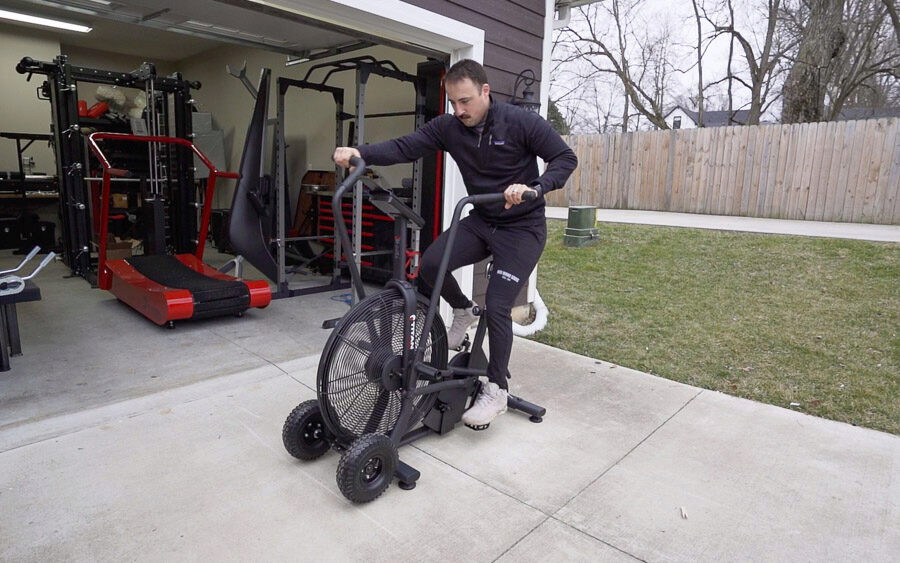 titan fan bike
titan fan bike
Key Features of Air Bikes:
- Fan Resistance: Utilizes a large fan as the primary resistance mechanism. The faster you pedal and push the handles, the greater the resistance becomes, providing a truly scalable workout.
- Moving Handles: Almost always equipped with moving handles that engage the upper body, allowing for a simultaneous arm and leg workout.
- Full-Body Workout: Engages both upper and lower body muscles, providing a comprehensive and highly effective workout.
- High-Intensity Training Powerhouse: Perfect for HIIT workouts, interval training, and pushing your cardiovascular limits.
- Low Impact (Despite Intensity): While delivering intense workouts, air bikes remain low impact, minimizing stress on joints.
Pros of Air Bikes:
- Extremely Intense Workouts: Capable of delivering incredibly challenging workouts, pushing your cardiovascular and muscular endurance to the max.
- Full-Body Engagement: The moving handles activate upper body muscles, providing a more comprehensive workout compared to other stationary bike types.
- Scalable Resistance: Resistance automatically adjusts to your effort level, making them suitable for various fitness levels and workout intensities.
- Durable and Robust: Built to withstand intense use, often featuring sturdy construction.
- Relatively Affordable: Generally priced in the mid-range compared to high-end indoor cycling bikes, offering excellent value for their workout capabilities.
Cons of Air Bikes:
- Noise: The fan-based resistance system is notoriously noisy, which can be disruptive in shared living spaces or for those sensitive to noise.
- Larger Footprint (Than Upright & Indoor Cycling Bikes): Typically have a larger footprint than upright and indoor cycling bikes due to the fan and robust frame.
- No Adjustable Resistance Settings: Resistance is solely determined by your effort; there are no pre-set resistance levels to adjust.
- Basic Monitors: Often feature simpler monitors with limited metrics compared to more technologically advanced bikes.
- Can Be Overwhelming for Beginners: The intensity can be challenging for beginners or those not accustomed to high-intensity training.
Folding Bikes
Folding bikes are the space-saving champions of the stationary bike world. Designed for portability and easy storage, they are ideal for individuals with limited space or those who need to move their bike frequently.
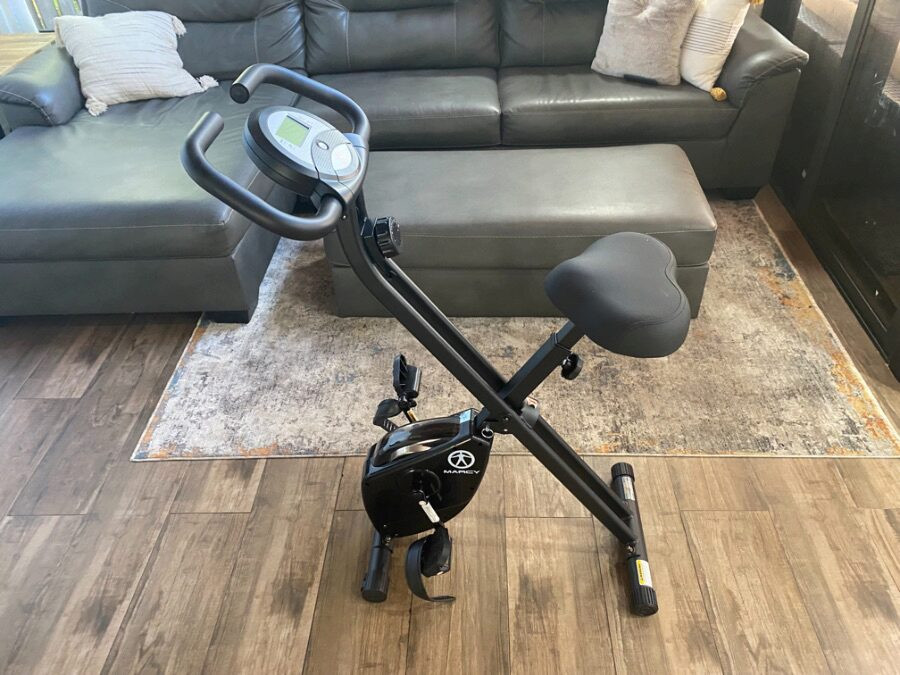 The Marcy Foldable Exercise Bike in a living room
The Marcy Foldable Exercise Bike in a living room
Key Features of Folding Bikes:
- Foldable Frame: Designed to fold into a compact size for easy storage in closets, corners, or under beds.
- Lightweight Construction: Often made from lighter materials to facilitate folding and portability.
- Upright Riding Position (Typically): Most folding bikes feature an upright riding posture, similar to standard upright bikes.
- Basic Features: Generally equipped with essential features and simpler consoles to maintain portability and affordability.
- Space-Saving Design: Primary focus is on minimizing storage space when not in use.
Pros of Folding Bikes:
- Extremely Space-Efficient: The folding design makes them incredibly convenient for small apartments, offices, or anyone with limited storage space.
- Easy Storage and Portability: Lightweight and foldable, allowing for easy movement and storage.
- Affordable: Often priced lower than other types of stationary bikes, making them budget-friendly.
- Convenient for Light Workouts: Suitable for light cardio, warm-ups, cool-downs, or casual cycling sessions.
Cons of Folding Bikes:
- Not Designed for High-Intensity Workouts: Lighter construction and folding mechanisms often compromise stability during vigorous workouts.
- Lower Maximum Weight Capacity: May have lower weight limits compared to sturdier stationary bike types.
- Basic Features and Durability: Typically lack advanced features, robust construction, and long-term durability compared to other stationary bike types.
- Can Feel Unstable at High Intensity: May feel less stable or wobble during intense pedaling due to their lightweight and foldable design.
- Limited Workout Experience: Primarily suited for light to moderate workouts, not ideal for serious training or performance goals.
Benefits of Using an Exercise Bike
Regardless of the type you choose, incorporating an exercise bike into your fitness routine offers a wealth of benefits:
- Improved Cardiovascular Health: Stationary biking is an excellent way to strengthen your heart, lower blood pressure, and improve overall cardiovascular function.
- Quick and Convenient Workouts: Perfect for fitting exercise into busy schedules, providing a readily accessible workout option at home.
- Low-Impact Exercise: Gentle on your joints, minimizing stress and making it suitable for people of all ages and fitness levels, including those with joint issues.
- Full Body Strengthening (Depending on Type): While primarily targeting the lower body, certain bikes like air bikes can also engage your upper body and core, contributing to overall strength.
- Enhanced Cardiovascular Endurance: Regular cycling builds stamina and endurance, allowing you to exercise for longer durations and improve your overall fitness capacity.
 Caroline using Echelon EX-8s bike
Caroline using Echelon EX-8s bike
Choosing the Right Stationary Bike for You
Selecting the best type of stationary bike ultimately depends on your individual needs, fitness goals, and preferences. Consider these factors when making your decision:
- Fitness Goals: Are you aiming for high-intensity training, low-impact cardio, rehabilitation, or casual fitness? Your goals will dictate the most suitable bike type.
- Budget: Stationary bikes range in price from a few hundred to several thousand dollars. Determine your budget and explore options within that range.
- Space Availability: Consider the space you have available in your home gym. Folding bikes are ideal for small spaces, while recumbent and air bikes require more room.
- Comfort and Accessibility: Think about your comfort preferences and any physical limitations. Recumbent bikes prioritize comfort and accessibility, while indoor cycling bikes are less forgiving in terms of seat comfort.
- Features and Technology: Do you want advanced features like interactive programming, heart rate monitoring, or digital resistance adjustments? These features can enhance your workout experience but also increase the price.
FAQs About Types of Exercise Bikes
What is the best type of exercise bike?
There’s no single “best” type of exercise bike. The ideal choice depends entirely on your individual needs and preferences. Consider your fitness goals, budget, space, and desired workout experience to determine which type is the best fit for you.
What should I look for when buying an exercise bike?
When purchasing a stationary bike, consider these key factors:
- Price: Set a budget and find a bike that offers the best value within your price range.
- Warranty: A good warranty indicates the manufacturer’s confidence in the bike’s durability and quality.
- Ergonomics and Comfort: Look for adjustable seats, comfortable seat padding, and handlebar adjustability to ensure a comfortable riding position.
- Resistance Type and Levels: Consider the type of resistance (magnetic, friction, air) and the range of resistance levels offered to match your workout intensity preferences.
- Programming and Features: Decide if you need interactive programming, workout tracking, or other advanced features to enhance your motivation and workout experience.
What is a stationary bike?
A stationary bike is an exercise machine that simulates cycling while remaining in a fixed position. It’s a versatile and effective tool for cardiovascular exercise, muscle strengthening, and overall fitness improvement, available in various types to suit different needs and preferences.
Final Thoughts
Choosing the right type of stationary bike is a crucial step in creating an effective and enjoyable home workout environment. By understanding the distinct characteristics of indoor cycling bikes, recumbent bikes, upright bikes, air bikes, and folding bikes, you can make an informed decision that aligns with your fitness goals, comfort preferences, and available space. Take the time to explore your options, consider your individual needs, and invest in a stationary bike that will motivate you to pedal your way to a healthier and fitter you.
Kate Meier, NASM-CPT, USAW-L1, CF-L1
Kate has nearly two decades of experience working in both the fitness and content industries. On the fitness side, she has worked in a number of settings: youth athletics, owned a CrossFit affiliate, personal training, weightlifting coach, CrossFit coach, and fitness floor consultant at a YMCA. Personally, Kate enjoys competing in weightlifting and stores her barbell in her bedroom.Certifications:NASM Certified Personal Trainer CrossFit Level 1 Trainer USA Weightlifting Level 1 Trainer

